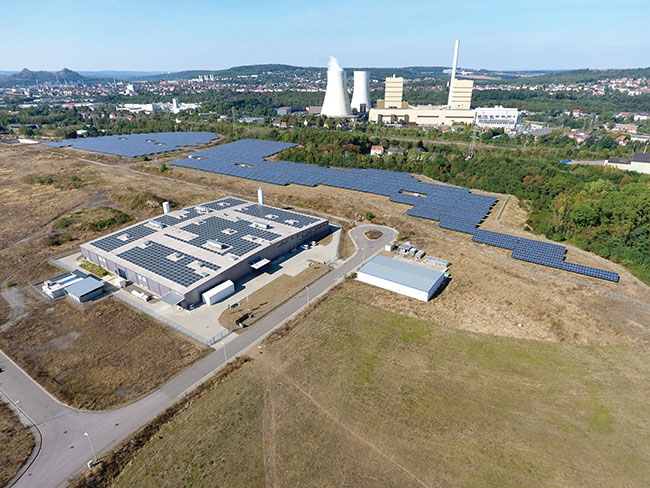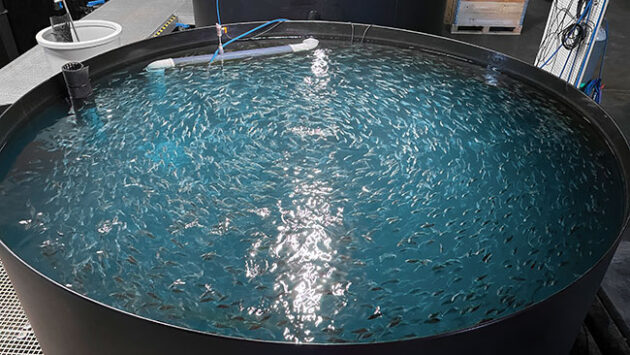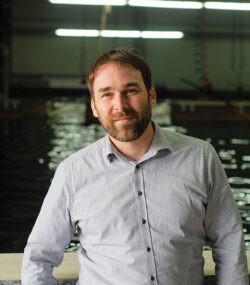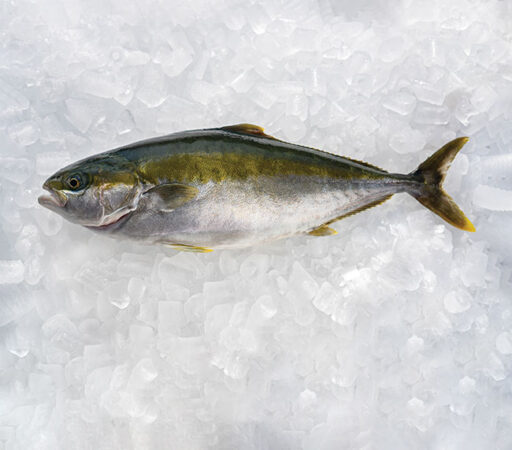
Features
InfiniteSea’s power play
InfiniteSEA CEO on his ambitions for carbon neutral RAS
February 10, 2023 By Colin Ley
 InfiniteSea’s Völklingen site is well-equipped with solar panels which covers all the farm’s core electricity needs during daylight hours. (Photo: InfiniteSea)
InfiniteSea’s Völklingen site is well-equipped with solar panels which covers all the farm’s core electricity needs during daylight hours. (Photo: InfiniteSea) The surge in energy costs, which put RAS systems around the globe under intense economic pressure in 2022, has been met with a strong response by the management team behind InfiniteSea, claimed to be the world’s first large-scale urban marine fish farm.
Located at Völklingen in the middle of Germany, a very long way from the nearest ocean, the InfiniteSea business is 12 months into a redevelopment programme which will ultimately see the company’s RAS structure producing 800 tonnes of Yellowtail kingfish and amberjack annually.
The venture will be deemed a success if that level of output is delivered at a markedly lower energy-to-end-product ratio than many RAS systems have traditionally achieved. In addition, with the farm progressively benefitting from its “state of the art” energy consumption, the business will also become economically profitable, which is always the ultimate goal.
“Working with other companies in the past I’ve been aware that energy consumption within RAS systems is generally relatively high, often running at six kWh per kilo of fish produced, or more,” said Andreas Mäck, CEO of InfiniteSea, to RAStech Magazine. “While this level of energy usage hasn’t been a major issue in the past for businesses in regions with low electricity costs, such as the north of Norway, it’s a totally difference equation in central Europe, especially following the recent price rises.”
Efficiency project
Prior to joining InfiniteSea in 2020, Mäck was part of a research team at the German aquaculture technology company SENECT, a specialist manufacturer of fish farming equipment, with a strong commitment to the development of new RAS technology.
Recognising that a high energy/output ratio is one of the major economic bottlenecks attached to RAS systems globally, he became involved with SENECT colleagues in a three-year production efficiency project. Funded by a grant from Germany’s Federal Ministry of Economic, the project was launched in 2018, long before Russia invaded Ukraine.
Today, of course, with the impact of the war in Ukraine resulting in an 11-fold increase in energy costs for InfiniteSea during 2022, lessons learned during the efficiency project are being put to good use as part of the redevelopment of the Völklingen enterprise.
“Our objective here is to examine all the different aspects of our existing RAS structure to ensure they are each working at optimum efficiency, very much in line with the core aspects of the SENECT-based project,” said Mäck. “This includes energy usage, which has become an increasingly important consideration for us over the past 12 months.”
Key focus points to date have involved seeking improvements in the Völklingen unit’s water treatment processes, adaptive control systems, drum filters, degassing procedure, and more.

Andreas Mäck (right) plans further efficiency steps by reducing its systems’ reliance on water aeration.
Pilot unit
“We began by establishing a small pilot unit consisting of three 2-cubic-metre tanks,” he said. “These were stocked with Arctic Char, a deliberate choice of species which allowed us to avoid running into output limitations caused by high stocking densities.
“Across our work so far, we have seen that the farm’s energy consumption can be reduced by 20-50 per cent, despite continuing to use already developed technology.
“Admittedly, some RAS equipment suppliers claim that one kWh per kilo of fish is achievable, but I’ve never seen that sort of performance being delivered under real commercial conditions, and I’ve visited several ‘low use’ operations to look for myself.”
Adding that many such ultra-low energy claims possibly fall into a :marketing category,” Mäck agreed there were several non-design/non-technology reasons why RAS-based units have an energy/output imbalance which doesn’t add up in terms of saleable fish production.
“Our own business here, for example, was built to produce 600 tonnes a year, but it never reached even half of that figure,” he said. “A similar gap between potential capacity and achieved commercial output is no doubt being repeated elsewhere, resulting in an industry average which is nearer 50-60 per cent of the expected production capacity than we’d like to admit as a RAS community.”
Clearly not content with their own site’s limited production, as recorded in the past, the management and ownership team behind InfiniteSea embarked on a total system rebuild in 2022, aligned with the goal of equipping the site to produce a total of 800 tonnes of Yellowtail kingfish and amberjack a year.
“Having gone back to basics in order to start again, we had to settle for an output of just 50 tonnes in 2022, all of which was kingfish,” said Dr Mäck. “We’re currently on schedule to install a capacity of 400 tonnes this year, however, and are well placed to achieve 800 tonnes in 2024.”
Achieving their longer-term production goal will be governed by emerging equipment supply challenges, of course, with one ordered item already subject to a 52-week delivery date, imposed by the provider.
“Progressing through the rebuild in annual steps, however, has given us an easier ride on energy costs so far than would otherwise have the case,” he said. “At the point when the first major surge in costs took effect, for example, we were only utilising about one quarter of our site so only had one quarter of our previous energy requirements to fund. While our costs will inevitably rise as output builds, we are at least able to plan ahead and adjust our systems in line with the farm’s energy efficiency goals.”
Solar power
The Völklingen site already benefits from being well-equipped with solar panels, a resource which covers all the farm’s core electricity needs during daylight hours, after which the unit switches to night-time grid supplies.

Andreas Mäck
“As for our further planned efficiency steps, we’re working on improvements to the control system which drives the entire RAS structure,” he said. “We’re also looking to reduce our reliance on aeration, which requires a lot of energy input and which we believe isn’t the way to go in the future, or at least that it can be done better than is currently being achieved.
“Another major focus is degassing, which is highly demanding in energy and cost terms. By using adaptive control algorithms, we’re convinced that our degassers can be operated much more effectively than they have been to date. As for the question of how much energy in total we can save once the redevelopment is complete, we’ll have a positive answer once we hit our 800-tonne target.”
No matter how difficult managing the individual parts of the Völklingen rebuilding programme may prove to be, however, the idea that rising energy costs could prevent RAS technology from having a role in the future of fish farming, isn’t even being considered.

InfiniteSEA CEO Andreas Mäck still believes that RAS is the future of fish farming, despite the challenge of rising energy costs.
RAS benefits persist
“Moving away from RAS, either as a business or an industry, isn’t a realistic option,” said Mäck. “The current rise in energy costs is obviously asking questions of the sector which haven’t been faced before, at least not to the present extent. As an industry, however, there is no way we can even begin to question whether or not the RAS approach to fish production in general has become too expensive.”
Pointing out that net pen fish farms are not necessarily low energy operations in themselves, taking ship and barge infrastructure into account, he added that a typical RAS structure could also have greater renewable energy potential than a comparable sea site, subject to the individual location involved.
“We already have our solar panels, for example, with the potential to become climate neutral with the use and development of other land-based technologies,” he said. “And we still have all the traditional RAS benefits linked to disease controls and waste disposal.
“Finally, the simple truth for most countries is that there are very few coastal locations still available for new developments to use, if any, and certainly not ones for which a production licence could be easily secured.
“The challenge, therefore, is to fine tune our industry’s existing RAS operations, shifting the sector’s performance average towards the two kWh per kilo of fish produced target which we’ve set for InfiniteSea. We’re confident this can be achieved for our own location, so why not elsewhere as well?”
Print this page